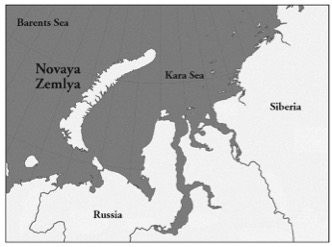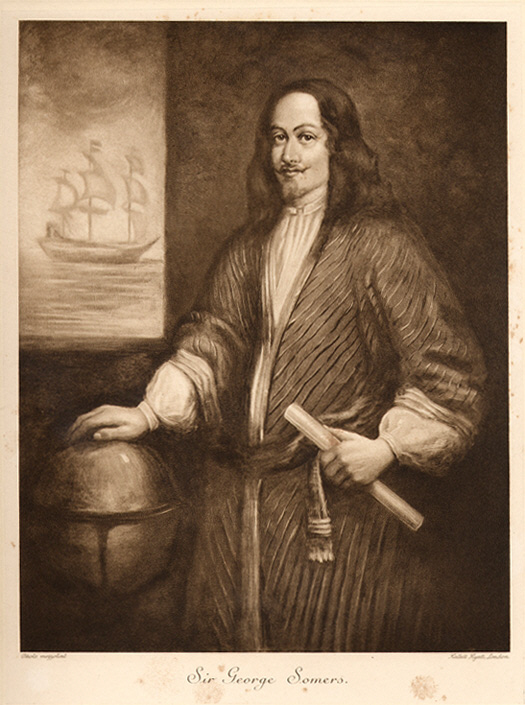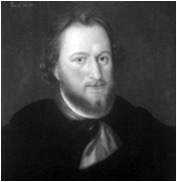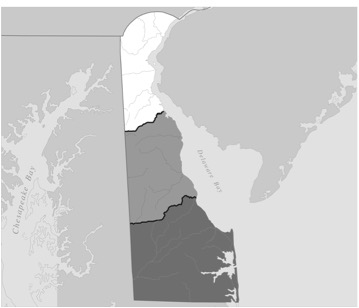DELAWARE
Q: What did Dela Wear?
A: Her New Jersey.
—old riddle
And I will see you again,
I will see you again,
a long time from now
—Dallas Green, Hello, I’m in Delaware
Obscurity
If any state suffers from obscurity, it must be Delaware. It is probably the least likely to be found on a map of the U.S. by all but the most geographically inclined Americans. Many of us, frankly, would be hard pressed to name a single city within the state, even the capital. Dover is the capital. Wilmington is the largest. While tiny, Delaware does not have the distinction of being the smallest state (Rhode Island), nor even the least populous (Wyoming). Delaware hosts no major sports teams and except for Delaware Bay—which it shares with New Jersey—has few recognizable landmarks to distinguish it.
If Delaware has a reputation at all it seems to have to do with the tax advantages of incorporating a business and of spending your shopping money within the state. While Delaware boasts a beautiful bay with beaches and islands, one of its most famous tourist attractions is the lack of state or local sales taxes. And for reasons that will make any non-MBA’s eyes glaze over, more than half of the publicly traded companies in the U.S. have chosen Delaware as the state in which their business is incorporated.
Delaware also has the reputation of being “owned” by the Dupont family. The name appears on countless buildings, roads, and even a state park. Eleuthere Irenee DuPont settled near Wilmington in 1800, having emigrated from France to escape that country’s revolution. Soon he became the leading supplier of gunpowder in the new United States, and over two centuries, the Dupont company has prided itself on the research and manufacturing of scientifically innovative products. It’s not difficult to guess where the company is incorporated.
There is one other thing which may seep into one’s consciousness when thinking of Delaware—Dover, Delaware, in particular. The U.S. Air Force base there is the entry point and mortuary for all U.S. servicemen/women and some U.S. government civilians who die overseas. During the Vietnam War, television footage from Dover of flag-draped coffins being offloaded from airplanes was an almost nightly occurrence and contributed to the welling dissatisfaction with the war. Because of that history, one of the many controversial issues of the Iraq War was the initial ban on any images coming out of Dover Air Force Base involving said coffins. The state may suffer from inconspicuousness but it sure knows how to involve itself in a political brouhaha.
For all of its obscurity as an American state, Delaware does boast perhaps the most eyebrow-raising superlative of them all. It was the first.
Discovering the Bay
The story of Delaware begins in the spring of 1609, when two ships went to sea. One, the Half Moon ( Halve Maan ), sailed out of Amsterdam under the auspices of the Dutch East India Company. The other, the Sea Venture , was at the head of a nine-ship fleet sailing to bring badly needed provisions to the occupants of Jamestown, a struggling colony in “Virginia” (as the east coast of North America was then called on British maps).
In command of the Dutch ship was Captain Henry Hudson, an Englishman, whose instructions were to try to find a north-east passage to the “spice islands,” or Southeast Asia. The Half Moon was commissioned specifically for this type of exploration, and this was her maiden voyage. Hudson got as far as Novaya Zemlya, a large archipelago that separates the Barents Sea from the Kara Sea inside the Arctic Circle north of Asia. Then he turned around, deciding either on his own or at the insistence of a mutinous crew, to search for a passage to the northwest instead. By July, Hudson’s ship was sailing the open waters of the Atlantic Ocean.

The Sea Venture was captained by George Somers, a widely respected English seaman in the employ of the Virginia Company. Somers was in charge of the entire nine-ship fleet, historically called the “Third Supply,” as it was intended to re-supply Jamestown with both provisions and people. Passengers on the Sea Venture included the new Lieutenant Governor of Jamestown, Sir Thomas Gates, as well as Pocahontas’ future husband, John Rolfe.

Admiral Sir George Somers
It turns out that the summer of 1609 was a bad time to be sailing the Atlantic Ocean anywhere near North America. Fierce storms and hurricanes battered ships from Maine to Florida. Hudson’s crew made multiple repairs to the Half Moon , including, at one point, replacing the mast. But the most famous storm was a hurricane that hit off the coast of North Carolina in late July that tossed and jostled the Third Supply fleet. One of its ships was lost, with all souls perishing. Seven others limped into the Jamestown colony with 600 or so passengers but without the necessary provisions to support them—those supplies having been lost overboard during the storm. The Sea Venture and her passengers miraculously crashed ashore on the island of Bermuda without losing a single life.
Bermuda, named for a Spanish sailor Juan Bermudez who found the island around 1503, was populated with pigs, thus the crew and passengers of the Sea Venture had plenty of pork to nourish them as they spent the next nine months using scraps from their ship to build two new ones, the Deliverance , and the Patience . The adventures of those aboard the Sea Venture would eventually make for fascinating news back in England and would inspire William Shakespeare to pen The Tempest . For a few years during the 17th century, the English referred to Bermuda as “Somers’ Island.”
Meanwhile in Jamestown Colony, life was harsh. The winter of 1609 and spring of 1610 saw the deaths of nearly all of the colonists due mainly to starvation. People resorted to eating snakes and horseflesh and even to cannibalism. Historically known as “the Starving Time,” as many as 600 colonists perished during these months, leaving only about 60 desperate and destitute souls.
It was August 28, 1609, during the time that Somers and his passengers and crew were shipbuilding on Bermuda and Jamestown was just beginning to experience hard times, when Henry Hudson sailed into Delaware Bay, noting it on maps for future European navigation. Hudson, however, did not name the bay. One of his men described it in a journal, along with the land and the natives, as he viewed them from the Half Moon . But the name that we use today for the bay, the river, and the state would come from someone else entirely. Hudson continued north along the coast and eventually reached the river that now bears his name.
Naming the Bay
In May of 1610, Somers and his crew sailed their two rebuilt pinnaces from Bermuda on to Jamestown and found the 60 survivors of the Starving Time. After about two weeks—and still without necessary provisions—the colony’s new Lieutenant Governor, Sir Thomas Gates, made the executive decision to abandon the colony. Several ships were loaded up and started down the river to Chesapeake Bay but less than twenty-four hours later, they were met by another English convoy.
Captain Samuel Argall, an experienced seaman at the helm of one of the arriving ships, instructed Somers to turn around and go back to Jamestown. A few days later Sir Thomas West, Lord de la Warr, arrived at Jamestown with a commission from the Virginia Company to take over as Governor of the colony. West and Argall began immediately creating new rules and new organization for Jamestown.

Within weeks of their arrival, Argall and Somers left Jamestown for Bermuda in order to “fetch six months’ provision of flesh and fish, and some live hogs to store our colony again.”1
Unlike Argall, Somers had recently spent the better part of a year on the island and presumably knew how to find it. But when they began to run out of food, water, and nautical “guidelines,”2 they sailed instead for Cape Cod, where they fished and restored their provisions. The two ships headed back to Jamestown, but fog and other bad weather separated them.
Somers sailed for Bermuda, this time successfully, but before he could load up with hogs and return to Jamestown, he died of food poisoning. Many historians assert that his illness was the result of eating too much pork. This assumption comes from the journals and contemporary reports that attribute his death to a “surfeit of pork.” More likely, however, is that he ate pork that had been undercooked and contracted a food-borne illness such as salmonella or trichinosis.
Meanwhile, Argall sailed south toward Jamestown. On August 27th he “came to an anchor in nine fathoms in a very great Bay,” where he found a “great store of people which were very kind.”3 Argall bestowed upon the bay and river the name “Delaware” after Sir Thomas West, Lord De La Warr.
Who?
Lord De La Warr was an early investor in the Virginia Company, which provided the initial investment for the establishment of an English colony in the Americas. In 1609, when the reports reached England of dismal, anarchic conditions in the Jamestown colony, the Company outfitted the ill-fated Sea Venture armada and sent the aforementioned George Somers and Third Supply to restore the colony. The Company also sought and was granted by King James I a new charter, replacing the governing council of the colony (of which John Smith had, until recently, been president), with a governor-general who would have much more control. Lord De La Warr was the first to receive the title “Governor-General of Jamestown.”
Though Lord De La Warr had been appointed governor for life of Virginia, he fell ill less than a year into his appointment and left the colony to return to England in March 1611. Not until 1618 did he sail again for Virginia, and on that trip he is said to have sailed into Delaware Bay, though other reports have him going no closer to Delaware than Bermuda. It was during this voyage that Thomas West, Lord De La Warr, died of an unidentified illness.
While the “De La Warr” name lived on in England as well as in America, it is clearly associated more with Virginia than Delaware. In 1870 Delaware historian Francis Vincent wrote “Earl Delaware, who lived in England a few years ago (and probably may be yet living) is a descendant of his. All, however, that he had to do with our State, was the honor of giving us a name.”4
And What a Name
The Surname “De La Warr” is not Spanish, as the two determiners “de” and “la” might indicate. Nor is it Latin, Anglo-Saxon, German, nor even French. Strictly speaking, it is a Viking name that can be traced back to the days beforeWilliam the Conqueror invaded England in 1066. In those days northern France was inhabited by Viking descendants who had pillaged and plundered the region in the 900s and then decided to stay. These North Men, or Normans (thus the name Normandy ), were among the followers of William the Conqueror when he gained control of England, and they were rewarded with land grants and seats in parliament.
The name De La Warr —also spelled Warre, Ware, Weare, Werre, and War and often without the “De”—begins to appear on census reports and land registries as early as the late 11th century. In 1125 a solid record of the lineage begins with Jordan de la Warre whose son was granted Wicken Manor in Gloucestershire by King Richard the Lionheart, and whose lordship was granted by Richard’s brother, King John.
One of King John’s childhood friends, it turns out, was a man named Fulk Fitzwarin. An old story goes that one day John and Fulk were playing a game of chess, and Fulk won. John angrily broke the chessboard over Fulk’s head, and in retaliation Fulk punched the Prince in the stomach. When John ran crying to his father, King Henry II, about the scuffle, Henry punished John for being a sore loser. Years later, when John became king, he retaliated against Fulk by stripping him of his ancestral lands, and awarding them to an enemy of Fulk’s. The feud between the two men lasted years, and some historians believe that Fulk Fitzwarin is the man upon whom the legend of Robin Hood is based.
Fitzwarin, it so happens, was the great-grandfather of Clarice de Tregoz who married Roger de la Warre; their descendant, Joan de la Warr was the mother of Sir Thomas West. While connecting the dots can make your head spin, and some suspension of disbelief is certainly required, the implication is that our Sir Thomas West is a direct descendant of Robin Hood.
The name De La Warr can be translated as “of the war” or “warrior.” The removal of the spaces in the name appears to be a true Americanism. In an article for a translators’ newsletter, Charles M. Stacy points out that other non-English words, when translated in America, were combined to form one word from two, three or more.5 Besides Delaware, he cites the conversion of “Van der Straaten” to “Vanderstraaten.” Another example is of course, “Dupont.”
Zwaanendael, New Sweden, and Beyond
In 1631 the first attempt at colonization along the Delaware River was made by a group of Dutch settlers. They called their small village Zwaanendael, or “Valley of Swans,” but in a dispute with local Indians that was touched off by the meaningless destruction of a coat of arms by a local native, the entire Dutch settlement was massacred. Then in 1638, a group of Swedish settlers under the leadership of Peter Minuit, a Dutchman who previously had governed New Amsterdam (see New York ), established Fort Christina near present-day Wilmington. As the colony grew, it became known as New Sweden and survived until the Dutch captured it and took control in 1655. Now the settlements along the Delaware River were part of New Amsterdam, which stretched all the way up to Manhattan and was captured by the English in 1664.
In 1681 King Charles II granted William Penn his colony of Pennsylvania, and later that same year, Penn obtained from the Duke of York (Charles’ brother) the counties on the south side of the Delaware River so that Pennsylvania would have a seaport. This touched off a dispute between Penn and Cecil Calvert, the 2nd Lord Baltimore, who had inherited his father’s royal charter for the province of Maryland. The dispute lasted almost one hundred years, with generations of the Penn and Calvert families taking up the cause through the decades. Finally, from 1763 until 1767, the border between Pennsylvania and Maryland was surveyed by Charles Mason and Jeremiah Dixon. Now firmly under the control of Pennsylvania, the eastern portion of what today is called the “DelMarVa Peninsula” was referred to as the “Three Lower Counties.”
Delaware may have been the first state, but it was the last of the thirteen colonies to be formed. Technically speaking, it wasn’t even a colony. The word “colony” implies a “mother” country, or some other state supplying the colony with people and provisions. Delaware was never a recognized English colony—always a part of Pennsylvania—but in 1702, after years of discontent with their parent government, the Lower Counties were allowed by Penn to govern themselves separately from Pennsylvania, though they still acknowledged that colony’s Royal governor as their own. They were called officially “The Counties of New Castle, Kent, and Sussex upon Delaware”—just “Delaware” for short—and they had their own legislative assembly.

Revolutionary rumblings were heard early in Delaware. In 1767, the same year that the Mason-Dixon survey was completed, John Dickinson wrote his famous “Letters from a Farmer in Pennsylvania,” which roused anti-British sentiments and called on colonists to rebel against the Stamp Act. Dickinson’s farm, as he states in the opening line of the first letter, was actually situated on the banks of the Delaware River in what is now Delaware just south of Dover.
On June 15th, 1776, with just one document, the Delaware Assembly declared itself separate—not only from England, but from Pennsylvania and the Penn family. “Separation Day” is still celebrated in New Castle, Delaware, every year in early June. In August of 1776 the legislature adopted a constitution that proclaimed in Article I, “The government of the counties of New-Castle, Kent and Sussex, upon Delaware, shall hereafter in all public and other writings be called The Delaware State.” Eleven years later, on December 7, 1787, Delaware became the first state to ratify the U.S. Constitution, giving it its very genuine source of pride as the “First State.” Five years after that, in 1792, the state would be renamed one final time in the second of Delaware’s constitutions. The change from “The Delaware State” to “The State of Delaware” took the emphasis, once and for all, off of the river and gave it firmly to the people on the east side of the Mason-Dixon line.
The Delaware Indians
The name “Delaware” applies not only to the state, the river, and the bay, but to the Native Americans whose ancestors inhabited the shores of the bay until the 17th century. While Europeans who made very early contact with native tribes clearly had difficulty communicating, it was rare—in fact, almost unheard of—for such an English name to be applied to any group of Indians. Much more common was the practice of using the name of a prominent Sachem to describe the whole tribe or using a name applied by a neighboring tribe. This makes the Delaware Indians unique to this day.
While Americans after the Revolution became enamored with the use of aboriginal names, the early Europeans considered them heathen and preferred to apply their own. Only out of necessity did they resort to using native appellations. Thus the name “Delaware” was rather casually applied to the Indians who inhabited the banks of that river. The name was descriptive and served the purpose for the Europeans of defining a group of people with whom they began to trade eagerly.
These natives, of course, had their own name for themselves. It was “Lenape” (len-ah’-pay) or “Leni-Lenape,” a name meaning simply “the people” or “the true people.” Often referred to as a “grandfather” tribe among other Algonquian-speaking groups, the Lenape were sometimes called upon to negotiate peace between warring or feuding tribes. They were not migratory. They had inhabited the Delaware basin for hundreds of years prior to European contact, and their population, by best estimates, numbered some 20,000 in the late 16th century. Their numbers diminished significantly, however, due mainly to disease introduced by Europeans, and by the end of the 17th century, only about four thousand remained.
The Delawares, though tenacious, chose in most cases not to fight with European settlers and were subsequently pushed westward for generations until, in 1866, they purchased a district from the Cherokee nation within the Indian Territory of Oklahoma. Most of the remaining tribe live today in and around Bartlesville and Anadarko, Oklahoma. In their own published literature is an explanation for why they continue to use the name “Delaware” to describe themselves:
The Lenape story is that when the Europeans first arrived a white man kept trying to ask a Lenape what tribe he belonged to, and he told him “Lenape.” For some reason the white man had trouble saying the word properly, and would say “Lenuhpee,” “Renahpay” and other mispronunciations. Finally he said “Lenape” correctly, and the Lenape said, “Nal në ndëluwèn! Nal në ndëluwèn!” (That’s what I said! That’s what I said!).
The white man heard the DULUWEN part and he said, “Oh, you said Delaware! So you are a Delaware. Now I know what to call you,” and the name stuck.
The Delawares have used the name ever since that time because they knew that the whites just could not say Lenape properly. Of course, when speaking to each other, Lenape people call themselves “Lenape.”6
End Notes
1. Barbour, Philip L., Pocahontas and Her World , (Boston, 1969), p.76.
2. Barbour, p.82.
3. Barbour, p.83.
4. Vincent, Francis, A History of the State of Delaware (Philadelphia, 1870), p.105.
5. Stacy, Charles M., “Much Ado About Nothing,” The AATIA Letter , September 1998, p. 8.
6. Delaware Tribe of Indians , “Frequently Asked Questions about the Lenape or Delaware Tribe,” http://www.delawaretribeofindians.nsn.us/faq.html, accessed 09/13/09.